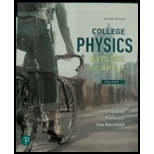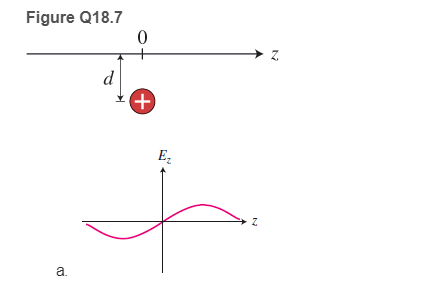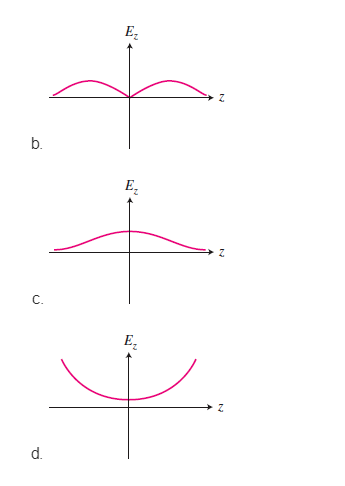
COLLEGE PHYSICS:VOL.1
2nd Edition
ISBN: 9780134862897
Author: ETKINA
Publisher: PEARSON
expand_more
expand_more
format_list_bulleted
Concept explainers
Textbook Question
Chapter 18, Problem 7MCQ
A positive charge is fixed at some distance d from the origin of the z-axis, as shown in Figure Q18.7. Which graph shows how
Figure Q18.7


Expert Solution & Answer
Want to see the full answer?
Check out a sample textbook solution
Students have asked these similar questions
PART II - RESISTORS IN SERIES
Consider (but do not yet build) the circuit shown in the circuit diagram to the left,
which we will call Circuit 2. Make sure you are using Bert bulbs. You may want
to wire two batteries in series rather than use a single battery.
4. Predict:
a) How will the brightness of bulb B₂ compare to the brighness to bulb
B2B?
X
B2A
E
Y
B2B
Ꮓ
b) How will the brightness of bulb B2A compare to the brightness of bulb B₁ from Circuit 1?
c) How will the currents at points X, Y, and Z be related?
d) How will the current at point X in this circuit compare to the current at point X from Circuit 1?
No chatgpt pls will upvote Already got wrong chatgpt answer
What is the practical benefit (in terms of time savings and efficiency) of defining the potential energy? Be clear about what is required in terms of calculation if we do not use the concept of potential energy.
Chapter 18 Solutions
COLLEGE PHYSICS:VOL.1
Ch. 18 - Review Question 18.1 How do you estimate the...Ch. 18 - Review Question 18.2 You have a point-like object...Ch. 18 - Review Question 18.3 Compare the work needed to...Ch. 18 - Review Question 18.4 Imagine that you have an...Ch. 18 - Review Question 18.5 In this section you read that...Ch. 18 - Review Question 18.6 What are the differences...Ch. 18 - Review Question 18.7 A parallel plate capacitor...Ch. 18 - Review Question 18.8 Why do heart contractions...Ch. 18 - 1 What does the field at point A, which is a...Ch. 18 - Why can you shield an object from an external...
Ch. 18 - If you place a block made of a conducting material...Ch. 18 - 4. If you place a block made of a dielectric...Ch. 18 - 5. Two identical positive charges are located at a...Ch. 18 - An electric dipole is placed between the...Ch. 18 - 7. A positive charge is fixed at some distance d...Ch. 18 - Figure Q18.8 shows E field lines in a region of...Ch. 18 - How do we use the model of the electric field to...Ch. 18 - Describe a procedure to determine the E field at...Ch. 18 - What does it mean if the E field at a certain...Ch. 18 - A very small positive charge is placed at one...Ch. 18 - 13. How do we create an E field with parallel...Ch. 18 - 14. Draw a sketch of the field lines caused by...Ch. 18 - 15. Draw a sketch of the field lines caused by...Ch. 18 - 16. Jim thinks that E field lines are the paths...Ch. 18 - Can E field lines cross? Explain why or why not.Ch. 18 - An electron moving horizontally from left to right...Ch. 18 - 19. (a) What does it mean if the electric...Ch. 18 - 20. Explain how grounding works.
Ch. 18 - 21. Explain how shielding works.
Ch. 18 - 22. Explain the difference between the microscopic...Ch. 18 - Explain why, for charged objects submerged in a...Ch. 18 - 24. What does it mean if the dielectric constant k...Ch. 18 - What is the dielectric constant of a metal?Ch. 18 - Describe the relation between the quantities E...Ch. 18 - If the V field in a region is constant, what is...Ch. 18 - 28. Why are uncharged pieces of a dielectric...Ch. 18 - 29. Draw equipotential surfaces and label them in...Ch. 18 - Show a charge arrangement and a point in space...Ch. 18 - 31. Explain what happens when you place a...Ch. 18 - (a) Explain what happens when you place a...Ch. 18 - 33. Explain why the excess charge on an electrical...Ch. 18 - Draw a microscopic representation of the charge...Ch. 18 - 1. * (a) Construct a graph of the magnitude of the...Ch. 18 - * A uranium nucleus has 92 protons. (a) Determine...Ch. 18 - 3. The electron and the proton in a hydrogen atom...Ch. 18 - * Use the superposition principle to draw E field...Ch. 18 - 5. * Use the superposition principle to draw ...Ch. 18 - * E field lines for a field created by an...Ch. 18 - 7. * Two objects with charges C are 50 cm from...Ch. 18 - 8. * charged object is 6.0 cm along a horizontal...Ch. 18 - 9. ** charged object is 4.0 cm along a horizontal...Ch. 18 - 10. **A distance d separates two objects, each...Ch. 18 - 11. * A point-like charged object with a charge +...Ch. 18 - 12. * A 3.0-g aluminum foil ball with a charge of ...Ch. 18 - 13. ** (a) If the string in the previous problem...Ch. 18 - * EST Using Earths E field for flight Earth has an...Ch. 18 - * An electron moving with a speed v0 enters a...Ch. 18 - 10-9 C hangs freely from a 1.0-m-long thread. What...Ch. 18 - 17. A 0.50-g oil droplet with charge is in a...Ch. 18 - 19. * Equation Jeopardy 1 The equations below...Ch. 18 - * Equation Jeopardy 2 The equations below describe...Ch. 18 - 21. During a lightning flash. of charge moves...Ch. 18 - 22. * (a) Construct a graph of the V field created...Ch. 18 - * A horizontal distance d separates two objects...Ch. 18 - * Two objects with charges qand+q are separated by...Ch. 18 - * Four objects with the same charge q are placed...Ch. 18 - 26. Spark jumps to nose An electric spark jumps...Ch. 18 - 27. * Two charged point-like objects are...Ch. 18 - BIO Electric field in body cell The electric...Ch. 18 - * Equation Jeopardy 3 The equation below describes...Ch. 18 - 31. * Equation Jeopardy 4 The equation below...Ch. 18 - 32. * While a sphere with positive charge remains...Ch. 18 - 33. * Figure P18.33 shows field lines in a region...Ch. 18 - 34. * A metal sphere has no charge on it. A...Ch. 18 - 35. ** EST A Van de Graaff generator of radius...Ch. 18 - ** A metal ball of radius R1 has a charge Q. Later...Ch. 18 - 37. * Positively charged metal sphere A is placed...Ch. 18 - *Two small metal spheres A and B have different...Ch. 18 - 39. * An electric dipole such as a water molecule...Ch. 18 - 10-7C at its head and an equal magnitude negative...Ch. 18 - 41. BIO Body cell membrane electric field (a)...Ch. 18 - 42. ** Earth's electric field Earth has an...Ch. 18 - 43. You have a parallel plate capacitor. (a)...Ch. 18 - 44. * A capacitor of capacitance C with a vacuum...Ch. 18 - 45. * A capacitor of capacitance C with a vacuum...Ch. 18 - How does the capacitance of a parallel plate...Ch. 18 - BIO EST Axon capacitance The long thin cylindrical...Ch. 18 - 48. ** Sphere capacitance A metal sphere of radius...Ch. 18 - * BIO EST Capacitance of red blood cell Assume...Ch. 18 - BIO Defibrillator During ventricular fibrillation...Ch. 18 - * EST The dielectric strength of air is 3106V/m....Ch. 18 - * Charged cloud causes electric field on Earth The...Ch. 18 - *BIO Hearts dipole charge The heart has a dipole...Ch. 18 - 55. * In a hot water heater, water warms when...Ch. 18 - 56. ** EST Lightning warms water A lightning flash...Ch. 18 - 57 * Four charged particles A, B, C, and D are...Ch. 18 - 59. ** A small object of unknown mass and charge...Ch. 18 - 61. * BIO Electrophoresis Electrophoresis is used...Ch. 18 - 62. * BIO Energy stored in axon electric field An...Ch. 18 - BIO Electric discharge by eels In several aquatic...Ch. 18 - BIO Electric discharge by eels In several aquatic...Ch. 18 - BIO Electric discharge by eels In several aquatic...Ch. 18 - BIO Electric discharge by eels In several aquatic...Ch. 18 - BIO Electric discharge by eels In several aquatic...Ch. 18 - BIO Electric discharge by eels In several aquatic...Ch. 18 - Electrostatic precipitator (esp) Electrostatic...Ch. 18 - Electrostatic precipitator (esp) Electrostatic...Ch. 18 - Electrostatic precipitator (esp) Electrostatic...Ch. 18 - Electrostatic precipitator (esp) Electrostatic...Ch. 18 - Electrostatic precipitator (esp) Electrostatic...
Additional Science Textbook Solutions
Find more solutions based on key concepts
List the types of electromagnetic radiation in order of decreasing energy per photon. a. gamma rays b. radio wa...
Introductory Chemistry (6th Edition)
2 Of the uterus, small intestine, spinal cord, and heart, which is/are in the dorsal body cavity?
Anatomy & Physiology (6th Edition)
Sketch the following spectra that would be obtained for 2-chloroethanol: a. The 1H NMR spectrum for an anhydrou...
Organic Chemistry (8th Edition)
WRITE ABOUT A THEME: INTERACTIONS In a short essay (100-150 words), identify the factor or factors in Figure 53...
Campbell Biology (11th Edition)
Q1. Which wavelength of light has the highest frequency?
a) 10 nm
b) 10 mm
c) 1 nm
d) 1 mm
Chemistry: A Molecular Approach (4th Edition)
27. Consider the reaction.
Express the rate of the reaction in terms of the change in concentration of each of...
Chemistry: Structure and Properties (2nd Edition)
Knowledge Booster
Learn more about
Need a deep-dive on the concept behind this application? Look no further. Learn more about this topic, physics and related others by exploring similar questions and additional content below.Similar questions
- What is the critical angle fir the light travelling from the crown glass(n=1.52) into the air(n=1.00)?arrow_forwardNo chatgpt pls will upvotearrow_forwardYou are working with a team that is designing a new roller coaster-type amusement park ride for a major theme park. You are present for the testing of the ride, in which an empty 150 kg car is sent along the entire ride. Near the end of the ride, the car is at near rest at the top of a 100 m tall track. It then enters a final section, rolling down an undulating hill to ground level. The total length of track for this final section from the top to the ground is 250 m. For the first 230 m, a constant friction force of 370 N acts from computer-controlled brakes. For the last 20 m, which is horizontal at ground level, the computer increases the friction force to a value required for the speed to be reduced to zero just as the car arrives at the point on the track at which the passengers exit. (a) Determine the required constant friction force (in N) for the last 20 m for the empty test car. Write AK + AU + AE int = W+Q + TMW + TMT + TET + TER for the car-track-Earth system and solve for…arrow_forward
- = 12 kg, and m3 Three objects with masses m₁ = 3.8 kg, m₂ find the speed of m3 after it moves down 4.0 m. m/s 19 kg, respectively, are attached by strings over frictionless pulleys as indicated in the figure below. The horizontal surface exerts a force of friction of 30 N on m2. If the system is released from rest, use energy concepts to m m2 m3 iarrow_forwardThree objects with masses m₁ = 3.8 kg, m₂ = 12 kg, and m 19 kg, respectively, are attached by strings over frictionless pulleys as indicated in the figure below. The horizontal surface exerts a force of friction of 30 N on m2. If the system is released from rest, use energy concepts to find the speed of m¸ after it moves down 4.0 m. m/s m m2 mgarrow_forwardIn order for Jane to return to base camp, she needs to swing across a river of width D that is filled with alligators. She must swing into a wind exerting constant horizontal force F, F = 110 N, L = 40.0 m, 0 = 50.0°, and her mass to be 50.0 kg. Wind →F Tarzan! Jane (a) with what minimum speed (in m/s) must Jane begin her swing to just make it to the other side? (If Jane can make it across with zero initial velocity, enter 0.) m/s on a vine having length L and initially making an angle with the vertical (see below figure). Take D = 48.0 m, (b) Shortly after Jane's arrival, Tarzan and Jane decide to swing back across the river (simultaneously). With what minimum speed (in m/s) must they begin their swing? Assume that Tarzan has a mass of 80.0 kg. m/sarrow_forward
- R=2.00 12V 2.00 4.00 4.002 What is the current in one of the 4.0 Q resistors? An isolated point charge q is located at point X. Two other points Y and Z are such that YZ2 XY. Y X What is (electric field at Y)/(electric field at Z)?arrow_forwardTwo objects (m₁ = 4.75 kg and m₂ 2.80 kg) are connected by a light string passing over a light, frictionless pulley as in the figure below. The 4.75-kg object is released from rest at a point h = 4.00 m above the table mg m (a) Determine the speed of each object when the two pass each other. m/s (b) Determine the speed of each object at the moment the 4.75-kg object hits the table. m/s (c) How much higher does the 2.80-kg object travel after the 4.75-kg object hits the table? marrow_forwardA cell of negligible internal resistance is connected to three identical resistors. The current in the cell is 3.0 A. The resistors are now arranged in series. What is the new current in the cell?arrow_forward
- A negatively charged sphere is falling through a magnetic field. north pole of magnet direction of motion south pole of magnet What is the direction of the magnetic force acting on the sphere?arrow_forwardElectrons in a conductor are moving down the page. A proton outside the wire is moving to the right. What is the direction of the magnetic force acting on the proton?arrow_forwardWhat is the resistance of an ideal voltmeter and the resistance of an ideal ammeter? Resistance of an ideal voltmeter Resistance of an ideal ammeter infinite A. zero B. zero zero C. infinite infinite D. infinite zeroarrow_forward
arrow_back_ios
SEE MORE QUESTIONS
arrow_forward_ios
Recommended textbooks for you
 Principles of Physics: A Calculus-Based TextPhysicsISBN:9781133104261Author:Raymond A. Serway, John W. JewettPublisher:Cengage Learning
Principles of Physics: A Calculus-Based TextPhysicsISBN:9781133104261Author:Raymond A. Serway, John W. JewettPublisher:Cengage Learning Physics for Scientists and Engineers, Technology ...PhysicsISBN:9781305116399Author:Raymond A. Serway, John W. JewettPublisher:Cengage Learning
Physics for Scientists and Engineers, Technology ...PhysicsISBN:9781305116399Author:Raymond A. Serway, John W. JewettPublisher:Cengage Learning Physics for Scientists and Engineers with Modern ...PhysicsISBN:9781337553292Author:Raymond A. Serway, John W. JewettPublisher:Cengage Learning
Physics for Scientists and Engineers with Modern ...PhysicsISBN:9781337553292Author:Raymond A. Serway, John W. JewettPublisher:Cengage Learning
 College PhysicsPhysicsISBN:9781305952300Author:Raymond A. Serway, Chris VuillePublisher:Cengage Learning
College PhysicsPhysicsISBN:9781305952300Author:Raymond A. Serway, Chris VuillePublisher:Cengage Learning College PhysicsPhysicsISBN:9781938168000Author:Paul Peter Urone, Roger HinrichsPublisher:OpenStax College
College PhysicsPhysicsISBN:9781938168000Author:Paul Peter Urone, Roger HinrichsPublisher:OpenStax College

Principles of Physics: A Calculus-Based Text
Physics
ISBN:9781133104261
Author:Raymond A. Serway, John W. Jewett
Publisher:Cengage Learning

Physics for Scientists and Engineers, Technology ...
Physics
ISBN:9781305116399
Author:Raymond A. Serway, John W. Jewett
Publisher:Cengage Learning

Physics for Scientists and Engineers with Modern ...
Physics
ISBN:9781337553292
Author:Raymond A. Serway, John W. Jewett
Publisher:Cengage Learning


College Physics
Physics
ISBN:9781305952300
Author:Raymond A. Serway, Chris Vuille
Publisher:Cengage Learning

College Physics
Physics
ISBN:9781938168000
Author:Paul Peter Urone, Roger Hinrichs
Publisher:OpenStax College
Electric Fields: Crash Course Physics #26; Author: CrashCourse;https://www.youtube.com/watch?v=mdulzEfQXDE;License: Standard YouTube License, CC-BY